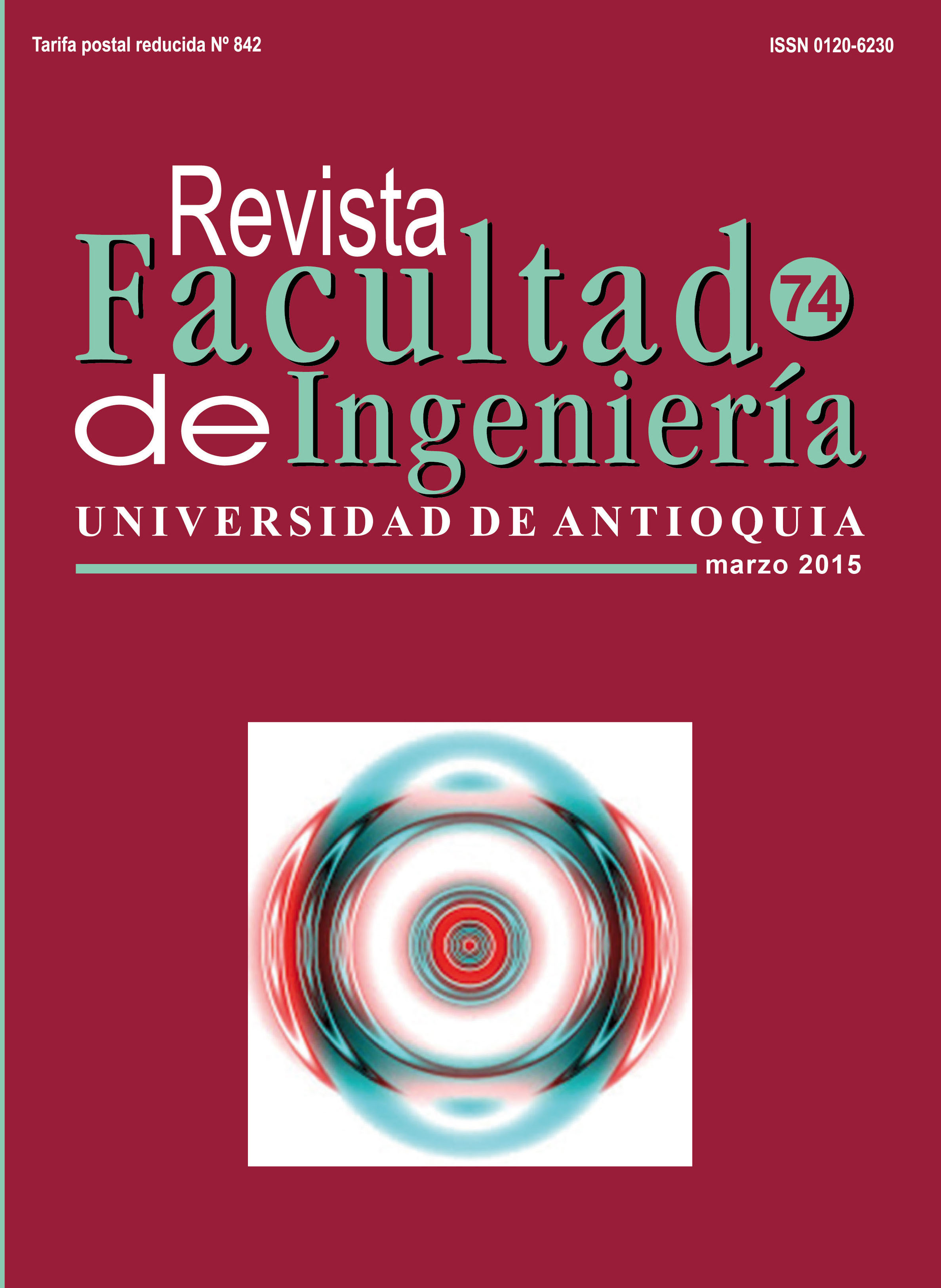An empirical method for the estimation of yield strength on bonds and strands of expanded metal meshes
DOI:
https://doi.org/10.17533/udea.redin.19073Keywords:
heat treatment, Vickers microhardness, yield strength, expanded metalAbstract
The manufacturing process of expanded metal meshes is based upon an in-line expansion of partially slit metal sheets, creating a pattern formed by strands and bonds. After this process, the mechanical properties of the base material change, especially in the bonds. Due to the size of strands and bonds it is difficult to quantify the amount of cold work that the base metal undergoes, hence the mechanical properties in the final meshes are difficult to predict. This paper presents an empirical method for the estimation of the yield strength on standard and flattened expanded metal, correlating Vickers microhardness with the yield strength using the Tabor’s relationship. In addition, the effect of various heat treatments on the yield strength of expanded metal was investigated. Results show that the yield strengths estimated through the Tabor’s equation are in good agreement with those obtained through standard mechanical testing, for various levels of cold work. In addition, it was found that the manufacturing process introduces some degree of heterogeneity and anisotropy in the material, and that long times of exposure to heat treatments are required to mitigate the effects of the cold work.
Downloads
References
D. Smith, C. Graciano, G. Martínez. “Recent patents on expanded metal”. Recent Patents on Materials Science. Vol. 2. 2009. pp. 209-225. DOI: https://doi.org/10.2174/1874464810902030209
National Association of Architectural Metal Manufacturers (NAAM). Standards for expanded metal. Standard EMMA 557-12. Illinois, USA. 2012. pp. 1-16. Available on: https://www.naamm.org/landing_pages/EMMA%20557-12.pdf Accessed: October 5, 2013.
G. Kooistra, H. Wadley. “Lattice truss structures from expanded metal sheet”. Materials and Design. Vol. 5. 2005. pp. 507-514. DOI: https://doi.org/10.1016/j.matdes.2005.08.013
D. Tabor. “A simple theory of static and dynamic hardness”. Proc. R. Soc. A. Vol. 192. 1947. pp. 247- 274. DOI: https://doi.org/10.1098/rspa.1948.0008
J. Nobre, A. Dias, M. Kornmeier. “An empirical methodology to estimate a local yield stress in workhardened surface layers”. Exp. Mech. Vol. 1. 2004. pp. 76-84. DOI: https://doi.org/10.1177/0014485104039755
B. Yavuz, A. Tekkaya. Correlation between Vickers hardness number and yield stress of cold formed products. Report N.° AFP-98-03-02-03. Sponsored by METU Graduate School of Natural and Applied Science. Middle East Technical University. Ankara, Turkey. 2000. pp. 1-10.
D. Tabor. “The hardness and strength of metals”. J. I. Metals. Vol. 79. 1951. pp. 1-18.
R. George, S. Dinda, A. Kasper. “Estimating yield strength from hardness data”. Metal Progress. Vol. 109. 1976. pp. 30-35.
J. Cahoon, W. Broughton, A. Kutzak. “The determination of yield strength from hardness measurement”. Metallurgical Transactions. Vol. 2. 1971. pp. 1979-1983. DOI: https://doi.org/10.1007/BF02913433
G. Dieter. Mechanical Metallurgy. 3rd ed. Ed. McGraw Hill. New York, USA. 1986. pp. 1-798.
P. Dung, A. Plumier. Behaviour of expanded metal panel under shear loading. Proceedings of International Colloquium Stability and Ductility of Steel Structures (SDSS’Rio). Rio de Janeiro, Brazil. 2010. pp. 1101-1108.
P. Dung. Seismically retrofitting and upgrading RCMRF by using expanded metal panels. Doctoral Thesis, University of Liege. Liege, Belgium. 2011. pp. 1-353.
M. Rambo, P. Mtenga, K. Walsh. “Missile impact resistance of a metal mesh roofing system”. Journal of Architectural Engineering ASCE. Vol. 18. 2011. pp. 199-205. DOI: https://doi.org/10.1061/(ASCE)AE.1943-5568.0000079
C. Graciano, G. Martínez, D. Smith. “Experimental investigation on the axial collapse of expanded metal tubes”. Thin-Walled Structures. Vol. 47. 2009. pp. 953- 961. DOI: https://doi.org/10.1016/j.tws.2009.02.002
C. Graciano, G. Martínez, A. Gutiérrez. “Failure mechanism of expanded metal tubes under axial crushing”. Thin-Walled Structures. Vol. 51. 2012. pp. 20-24. DOI: https://doi.org/10.1016/j.tws.2011.11.001
G. Martínez, C. Graciano, P. Teixeira. “Energy absorption of axially crushed expanded metal tubes”. Thin-Walled Structures. Vol. 71. 2013. pp. 134-146. DOI: https://doi.org/10.1016/j.tws.2013.05.003
D. Smith, C. Graciano, G. Martínez. “Quasi-static axial compression of concentric expanded metal tubes”. Thin-Walled Structures. Vol. 84. 2014. pp. 170–176. DOI: https://doi.org/10.1016/j.tws.2014.06.012
D. Smith, C. Graciano, G. Martínez, P. Teixeira. “Axial crushing of flattened expanded metal tubes”. Thin-Walled Structures. Vol. 85. 2014. pp. 42-49. DOI: https://doi.org/10.1016/j.tws.2014.08.001
R. Sánchez. Determinación de las propiedades mecánicas de láminas de metal expandido. Master Thesis, Universidad Simón Bolívar. Caracas, Venezuela. 2005. pp. 1-102.
R. Sánchez, C. Graciano. Determinación de las propiedades mecánicas de láminas de metal expandido. Memorias del 7º Congreso Iberoamericano de Ingeniería Mecánica. México D.F., México. 2007. pp. 1-7.
G. Aparicio, H. D’Armas. “Influencia del tratamiento térmico y del trabajo en frío en el comportamiento mecánico de láminas de acero ASTM A-569”. Rev. Ing. UC. Vol. 13. 2006. pp. 43-52.
ASTM International.Standard guide for preparation of metallographic specimens. Standard ASTM E3, ASTM International. 2011. West Conshohocken, USA. pp. 1-13.
ASTM International.Test Method for Microindentation Hardness of Materials. Standard ASTM E384-99, ASTM International. 1999. West Conshohocken, USA. pp. 1-24.
ASTM International.Hardness Conversion Tables for Metals Relationship Among Brinell Hardness, Vickers Hardness, Rockwell Hardness, Superficial Hardness, Knoop Hardness, and Scleroscope Hardness. Standard ASTM E140-02, ASTM International. 2002. West Conshohocken, USA. pp. 1-25
Downloads
Published
How to Cite
Issue
Section
License
Copyright (c) 2018 Revista Facultad de Ingeniería

This work is licensed under a Creative Commons Attribution-NonCommercial-ShareAlike 4.0 International License.
Revista Facultad de Ingeniería, Universidad de Antioquia is licensed under the Creative Commons Attribution BY-NC-SA 4.0 license. https://creativecommons.org/licenses/by-nc-sa/4.0/deed.en
You are free to:
Share — copy and redistribute the material in any medium or format
Adapt — remix, transform, and build upon the material
Under the following terms:
Attribution — You must give appropriate credit, provide a link to the license, and indicate if changes were made. You may do so in any reasonable manner, but not in any way that suggests the licensor endorses you or your use.
NonCommercial — You may not use the material for commercial purposes.
ShareAlike — If you remix, transform, or build upon the material, you must distribute your contributions under the same license as the original.
The material published in the journal can be distributed, copied and exhibited by third parties if the respective credits are given to the journal. No commercial benefit can be obtained and derivative works must be under the same license terms as the original work.










 Twitter
Twitter